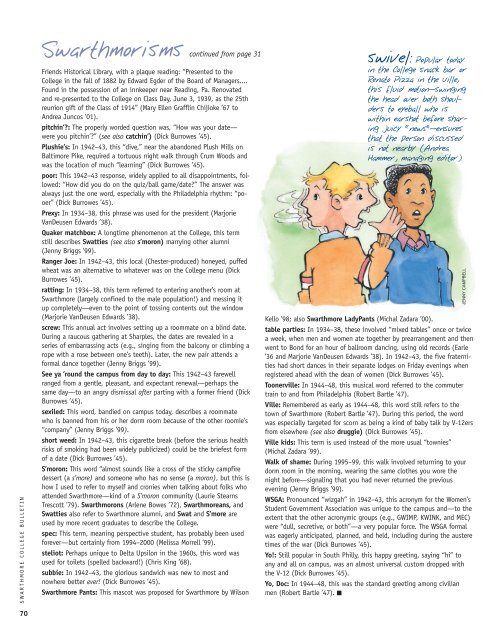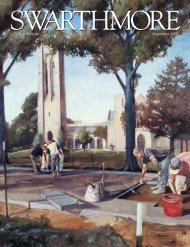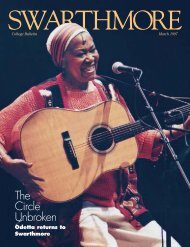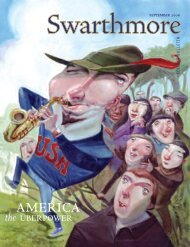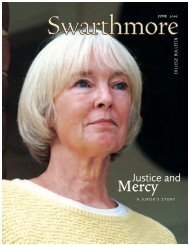SWARTHMORE
Swarthmore College Bulletin (September 2000) - ITS
Swarthmore College Bulletin (September 2000) - ITS
- No tags were found...
You also want an ePaper? Increase the reach of your titles
YUMPU automatically turns print PDFs into web optimized ePapers that Google loves.
S W A R T H M O R E C O L L E G E B U L L E T I NSwarthmorisms continued from page 31Friends Historical Library, with a plaque reading: “Presented to theCollege in the fall of 1882 by Edward Egder of the Board of Managers....Found in the possession of an innkeeper near Reading, Pa. Renovatedand re-presented to the College on Class Day, June 3, 1939, as the 25threunion gift of the Class of 1914” (Mary Ellen Grafflin Chijioke ’67 toAndrea Juncos ’01).pitchin’?: The properly worded question was, “How was your date—were you pitchin’?” (see also catchin’) (Dick Burrowes ’45).Plushie’s: In 1942–43, this “dive,” near the abandoned Plush Mills onBaltimore Pike, required a tortuous night walk through Crum Woods andwas the location of much “learning” (Dick Burrowes ’45).poor: This 1942–43 response, widely applied to all disappointments, followed:“How did you do on the quiz/ball game/date?” The answer wasalways just the one word, especially with the Philadelphia rhythm: “pooer”(Dick Burrowes ’45).Prexy: In 1934–38, this phrase was used for the president (MarjorieVanDeusen Edwards ’38).Quaker matchbox: A longtime phenomenon at the College, this termstill describes Swatties (see also s’moron) marrying other alumni(Jenny Briggs ’99).Ranger Joe: In 1942–43, this local (Chester-produced) honeyed, puffedwheat was an alternative to whatever was on the College menu (DickBurrowes ’45).ratting: In 1934–38, this term referred to entering another’s room atSwarthmore (largely confined to the male population!) and messing itup completely—even to the point of tossing contents out the window(Marjorie VanDeusen Edwards ’38).screw: This annual act involves setting up a roommate on a blind date.During a raucous gathering at Sharples, the dates are revealed in aseries of embarrassing acts (e.g., singing from the balcony or climbing arope with a rose between one’s teeth). Later, the new pair attends aformal dance together (Jenny Briggs ’99).See ya ’round the campus from day to day: This 1942–43 farewellranged from a gentle, pleasant, and expectant renewal—perhaps thesame day—to an angry dismissal after parting with a former friend (DickBurrowes ’45).sexiled: This word, bandied on campus today, describes a roommatewho is banned from his or her dorm room because of the other roomie’s“company” (Jenny Briggs ’99).short weed: In 1942–43, this cigarette break (before the serious healthrisks of smoking had been widely publicized) could be the briefest formof a date (Dick Burrowes ’45).S’moron: This word “almost sounds like a cross of the sticky campfiredessert (a s’more) and someone who has no sense (a moron), but this ishow I used to refer to myself and cronies when talking about folks whoattended Swarthmore—kind of a S’moron community (Laurie StearnsTrescott ’79). Swarthmorons (Arlene Bowes ’72), Swarthmoreans, andSwatties also refer to Swarthmore alumni, and Swat and S’more areused by more recent graduates to describe the College.spec: This term, meaning perspective student, has probably been usedforever—but certainly from 1994–2000 (Melissa Morrell ’99).steliot: Perhaps unique to Delta Upsilon in the 1960s, this word wasused for toilets (spelled backward!) (Chris King ’68).subbie: In 1942–43, the glorious sandwich was new to most andnowhere better ever! (Dick Burrowes ’45).Swarthmore Pants: This mascot was proposed for Swarthmore by Wilsonswivel: Popular todayin the College snack bar orRenato Pizza in the Ville,this fluid motion--swingingthe head over both shouldersto eyeball who iswithin earshot before sharingjuicy “news”--ensuresthat the person discussedis not nearby (AndreaHammer, managing editor).Kello ’98; also Swarthmore LadyPants (Michal Zadara ’00).table parties: In 1934–38, these involved “mixed tables” once or twicea week, when men and women ate together by prearrangement and thenwent to Bond for an hour of ballroom dancing, using old records (Earle’36 and Marjorie VanDeusen Edwards ’38). In 1942–43, the five fraternitieshad short dances in their separate lodges on Friday evenings whenregistered ahead with the dean of women (Dick Burrowes ’45).Toonerville: In 1944–48, this musical word referred to the commutertrain to and from Philadelphia (Robert Bartle ’47).Ville: Remembered as early as 1944–48, this word still refers to thetown of Swarthmore (Robert Bartle ’47). During this period, the wordwas especially targeted for scorn as being a kind of baby talk by V-12ersfrom elsewhere (see also druggie) (Dick Burrowes ’45).Ville kids: This term is used instead of the more usual “townies”(Michal Zadara ’99).Walk of shame: During 1995–99, this walk involved returning to yourdorm room in the morning, wearing the same clothes you wore thenight before—signaling that you had never returned the previousevening (Jenny Briggs ’99).WSGA: Pronounced “wizgah” in 1942–43, this acronym for the Women’sStudent Government Association was unique to the campus and—to theextent that the other acronymic groups (e.g., GWIMP, KWINK, and MEC)were “dull, secretive, or both”—a very popular force. The WSGA formalwas eagerly anticipated, planned, and held, including during the austeretimes of the war (Dick Burrowes ’45).Yo!: Still popular in South Philly, this happy greeting, saying “hi” toany and all on campus, was an almost universal custom dropped withthe V-12 (Dick Burrowes ’45).Yo, Doc: In 1944–48, this was the standard greeting among civilianmen (Robert Bartle ’47). ■JENNY CAMPBELL70


